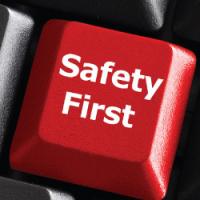- Posts: 350
- Thank you received: 11
Utility Knife Safety
- Safety Toolbox Talk Webmaster
-
 Topic Author
Topic Author - Offline
- Administrator
-

There’s one hand tool that demands your respect over many others in the workplace, a tool that can cut you to the bone in an instant . . . the utility knife.
Many workers use utility knives to cut strapping, puncture shrinkwrap and open packaging. But one wrong move and these retractable blades can do serious harm.
In fact, nearly 40 percent of all injuries attributed to manual workshop tools in the US involve knives with retractable blades.
Many accidents involving utility knives occur for the following reasons:
- Drawing the knife towards you instead of away from your body.
- Working with a dull blade. (Dull blades require more pressure, increasing the potential for injury.)
- Trying to cut more than the knife can handle.
- Improperly storing the knife with the blade extended.
- Failing to wear personal protective equipment.
- Neglecting to inspect the tool before use.
There have been cases where workers have suffered injuries from exposed blade tips. This is because the blades did not completely retract into the handle. That’s why it’s important for workers to use the proper size blades or replace defective retraction mechanisms. Some companies use self-retracting utility knives – the blade automatically retracts into the handle when not in use.
Problems also arise when some employees don’t have or can’t find a utility knife supplied by the company. As a result, they tend to use whatever is handy, such as a pocket knife or other tool with a sharp edge. This can quickly turn hazardous if the tool slips or is used incorrectly.
The following are safety precautions to keep in mind when using utility knives:
- Wear safety glasses to protect your eyes in case a blade breaks.
- Always use a sharp blade. They are safer than a dull blade.
- Wear cut resistant gloves and sleeves (at least Level 3) to protect your hands and arms.
- Hand a utility knife to a co-worker with the handle first.
- Use one of the newer model self-retracting blade knives. The technology has increased the safety of this tool tremendously over the past several years.
- If the application allows, use one of the new knives with a shielded knive surface such as the Klever Kutter or similar.
- Consider using a rounded tip blade if the application allows for such.
- Ensure the blades are properly positioned in the handle before use.
- Keep extremities out of the cutting path.
- Don’t apply too much pressure on the blade.
- Follow manufacturer’s instructions when changing blades.
- Don’t use utility knives to pry loose objects.
- Dispose of dull or broken blades in a puncture-resistant container.
- Use of diposable knives with breakaway blades is not meant for industrial use. Stay away from them.
Utility knives are extremely handy on the job, but they can also be handy in causing serious injuries.
Please Log in or Create an account to join the conversation.
